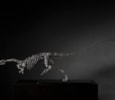Enigmacursor Skeleton
Enigmacursor Skeleton
Late Jurassic, circa 150 million years old
USA
Fossilised Bone
H: 64 x W: 25 x L: 182 cm
Sold
Enigmacursor- originally misidentified as a Nanosaurus (‘small or dwarf lizard’) is a genus of dinosaur that lived about 155 to 148 million years ago. Nanosaurus was described and named by Othniel Charles Marsh (October 29, 1831 – March 18, 1899), an American professor of Palaeontology at Yale College and President of the National Academy of Sciences, in 1877 – originally called Othnielia or Othenielosaurus. He was one of the preeminent scientists in the field of palaeontology. Among his legacies is the discovery or description of dozens of new species and theories on the origins of birds. In 2018, Othenielia, Othnielosaurus, and Drinker were made synonymous with Nanosaurus. However, after newly published research by the Natural History Museum, London, this dinosaur has now been identified as a new species, an Enigmacursor.
It is thought this species was social, speedy, and possibly even feathered; this herbivore was the friendly ‘Roadrunner’ of its time. Thriving on its wits at the feet of Jurassic giants like T Rex and Diplodocus.
Less than ten viable fossil specimens associated with the original identification of Nanosaurus have been unearthed since the first example was discovered in 1877, and all Nanosaurus specimens have been discovered in the Late Jurassic Morrison Formation in the western United States. The Morrison is by far the most famous and productive dinosaurbearing formation in North America and represents one of the best terrestrial Mesozoic formations in the world.
Named after the town of Morrison, Colorado, the Morrison Formation is centred in Colorado and Wyoming, but exposures are found across several other states, including Utah, Montana, South Dakota, Nebraska, Arizona, New Mexico and Kansas.
Found and excavated in 2021-22 in Moffat County, Colorado on the Skull Creek Estates (lots 37 and 38)










 Enquire
Enquire




